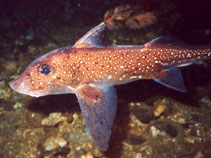| Family: |
Chimaeridae (Shortnose chimaeras or ratfishes) |
| Max. size: |
100 cm TL (male/unsexed) |
| Environment: |
bathydemersal; marine; depth range 0 - 913 m |
| Distribution: |
Northeastern Pacific: west coast of North America from southwestern Alaska to Baja California, Mexico, including the Gulf of California, and Costa Rica. |
| Diagnosis: |
This species is distinguished by the following characters: short and bluntly rounded snout; oral and preopercular lateral line canals not sharing a short common branch from the infraorbital canal; anterior edge of dorsal-fin spine non-serrated; anterior and posterior regions of second dorsal-fin considerably taller than the middle region; pectoral fins when depressed do not reach beyond to origin of pelvic fins; no anal fin; caudal-fin axis horizontal with the fin nearly symmetrical, epaxial
and hypaxial lobes equal sized; coloration brown or reddish brown with small white spots on head and trunk (Ref. 97389). |
| Biology: |
Found near the bottom, from close inshore to about 913 m (Ref. 2850). Abundant in cold waters at moderate depths. Feed on mollusks, crustaceans and fishes (Ref. 37955); also echinoderms and worms (Ref. 28499). The spine can be dangerous and cause a painful wound (Ref. 2850). Fishers are reputed to fear the jaws of the ratfish more than they do the dorsal spine. Its flesh is edible but bland and leaves an unpleasant aftertaste (Ref. 28499). The liver was used as a source of machine oil (Ref. 28499). |
| IUCN Red List Status: |
Least Concern (LC); Date assessed: 04 May 2024 Ref. (130435)
|
| Threat to humans: |
traumatogenic |
Source and more info: www.fishbase.org. For personal, classroom, and other internal use only. Not for publication.
